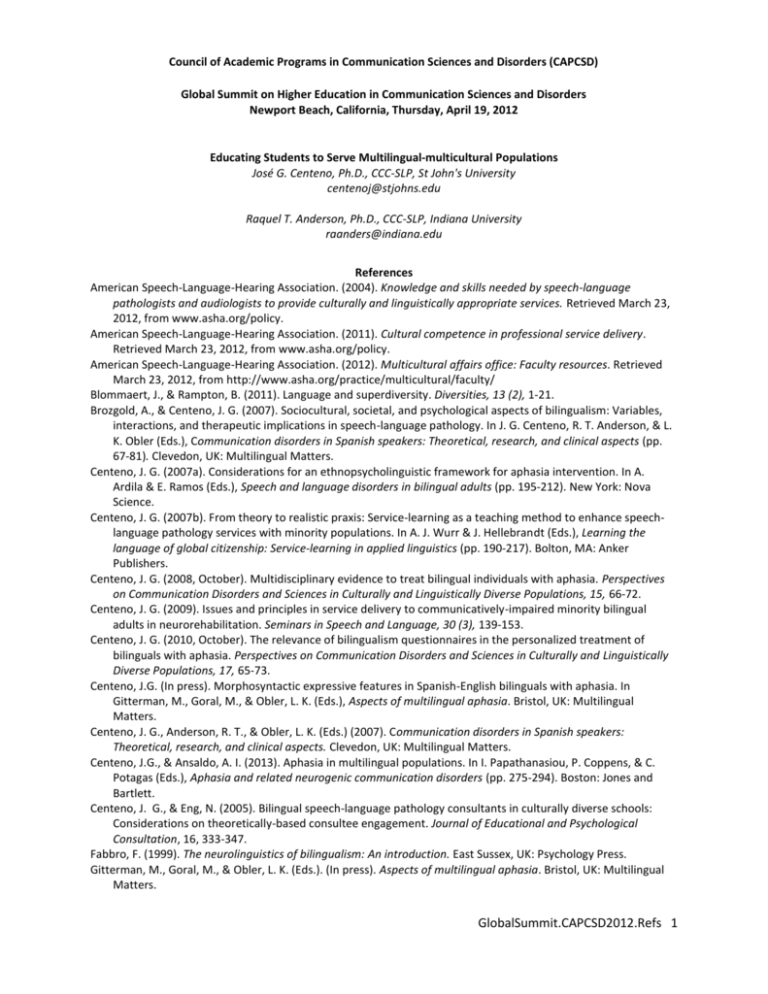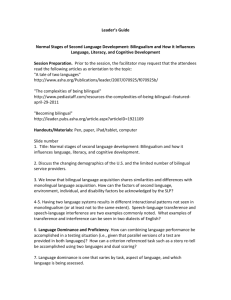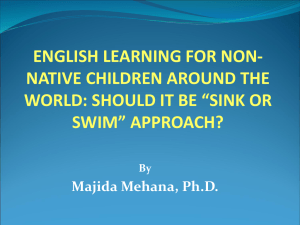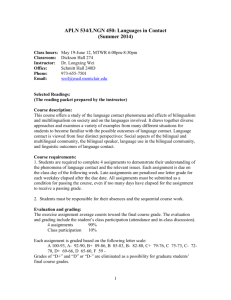7.Multilingual-Cente.. - capcsd
advertisement

Council of Academic Programs in Communication Sciences and Disorders (CAPCSD) Global Summit on Higher Education in Communication Sciences and Disorders Newport Beach, California, Thursday, April 19, 2012 Educating Students to Serve Multilingual-multicultural Populations José G. Centeno, Ph.D., CCC-SLP, St John's University centenoj@stjohns.edu Raquel T. Anderson, Ph.D., CCC-SLP, Indiana University raanders@indiana.edu References American Speech-Language-Hearing Association. (2004). Knowledge and skills needed by speech-language pathologists and audiologists to provide culturally and linguistically appropriate services. Retrieved March 23, 2012, from www.asha.org/policy. American Speech-Language-Hearing Association. (2011). Cultural competence in professional service delivery. Retrieved March 23, 2012, from www.asha.org/policy. American Speech-Language-Hearing Association. (2012). Multicultural affairs office: Faculty resources. Retrieved March 23, 2012, from http://www.asha.org/practice/multicultural/faculty/ Blommaert, J., & Rampton, B. (2011). Language and superdiversity. Diversities, 13 (2), 1-21. Brozgold, A., & Centeno, J. G. (2007). Sociocultural, societal, and psychological aspects of bilingualism: Variables, interactions, and therapeutic implications in speech-language pathology. In J. G. Centeno, R. T. Anderson, & L. K. Obler (Eds.), Communication disorders in Spanish speakers: Theoretical, research, and clinical aspects (pp. 67-81). Clevedon, UK: Multilingual Matters. Centeno, J. G. (2007a). Considerations for an ethnopsycholinguistic framework for aphasia intervention. In A. Ardila & E. Ramos (Eds.), Speech and language disorders in bilingual adults (pp. 195-212). New York: Nova Science. Centeno, J. G. (2007b). From theory to realistic praxis: Service-learning as a teaching method to enhance speechlanguage pathology services with minority populations. In A. J. Wurr & J. Hellebrandt (Eds.), Learning the language of global citizenship: Service-learning in applied linguistics (pp. 190-217). Bolton, MA: Anker Publishers. Centeno, J. G. (2008, October). Multidisciplinary evidence to treat bilingual individuals with aphasia. Perspectives on Communication Disorders and Sciences in Culturally and Linguistically Diverse Populations, 15, 66-72. Centeno, J. G. (2009). Issues and principles in service delivery to communicatively-impaired minority bilingual adults in neurorehabilitation. Seminars in Speech and Language, 30 (3), 139-153. Centeno, J. G. (2010, October). The relevance of bilingualism questionnaires in the personalized treatment of bilinguals with aphasia. Perspectives on Communication Disorders and Sciences in Culturally and Linguistically Diverse Populations, 17, 65-73. Centeno, J.G. (In press). Morphosyntactic expressive features in Spanish-English bilinguals with aphasia. In Gitterman, M., Goral, M., & Obler, L. K. (Eds.), Aspects of multilingual aphasia. Bristol, UK: Multilingual Matters. Centeno, J. G., Anderson, R. T., & Obler, L. K. (Eds.) (2007). Communication disorders in Spanish speakers: Theoretical, research, and clinical aspects. Clevedon, UK: Multilingual Matters. Centeno, J.G., & Ansaldo, A. I. (2013). Aphasia in multilingual populations. In I. Papathanasiou, P. Coppens, & C. Potagas (Eds.), Aphasia and related neurogenic communication disorders (pp. 275-294). Boston: Jones and Bartlett. Centeno, J. G., & Eng, N. (2005). Bilingual speech-language pathology consultants in culturally diverse schools: Considerations on theoretically-based consultee engagement. Journal of Educational and Psychological Consultation, 16, 333-347. Fabbro, F. (1999). The neurolinguistics of bilingualism: An introduction. East Sussex, UK: Psychology Press. Gitterman, M., Goral, M., & Obler, L. K. (Eds.). (In press). Aspects of multilingual aphasia. Bristol, UK: Multilingual Matters. GlobalSummit.CAPCSD2012.Refs 1 Goldstein, B. (2011, ed.), Bilingual language development and disorders in Spanish-English speakers (2nd ed.). Baltimore, MD: Brookes Publishing. Goral, M., Levy, E., & Obler, L. K. (2002). Neurolinguistic aspects of bilingualism. International Journal of Bilingualism, 6, 411-440. Gordon, R. G. (Ed.) (2005). Ethnologue: Languages of the world (15th ed.). Dallas, TX: SIL International. Institute of Education Sciences. (2012). English language learners. Fast Facts. Retrieved on April 06, 2012, from nce.ed.gov/fastfacts/display.asp?id=96 Juncos-Rabadán, O. (1994). The assessment of bilingualism in normal aging with the Bilingual Aphasia Test. Journal of Neurolinguistics, 8, 67-73. Kiran, S., & Edmonds, L. A. (2004). Effect of semantic naming treatment on crosslinguistic generalization in bilingual aphasia. Brain and Language, 91, 71-77. Kohnert, K. (2008). Language disorders in bilingual children and adults. San Diego, CA: Plural. Kohnert, K. (2009). Cross-language generalization following treatment in bilingual speakers with aphasia: A review. Seminars in Speech and Language, 30, 174-186. Kohnert, K., Kennedy, M. R. T., Glaze, L., Kan, P. F., & Carney, E. (2003). Breadth and depth of diversity in Minnesota: Challenges to clinical service competency. American Journal of Speech-Language Pathology, 12, 259-272. Lubinski, R., & Matteliano, M.A. (2008). A guide to cultural competence in the curriculum: Speech-language pathology. Buffalo, NY: Center for International Rehabilitation Research Information and Exchange. Martin, D. (2009). Language disabilities in cultural and linguistic diversity. Bristol, UK: Multilingual Matters. Muñoz, M. L., & Marquardt, T. P. (2008). The performance of neurologically normal bilingual speakers of Spanish and English on the short version of the Bilingual Aphasia Test. Aphasiology, 22, 3-19. Muñoz, M. L., Marquardt, T. P., & Copeland, G. (1999). A comparison of the codeswitching patterns of aphasic and neurologically normal bilingual speakers of English and Spanish. Brain and Language, 66, 249-274. Paradis, J., Genesee, F., & Crago, M. B. (2011). Dual language development and disorders: A handbook on bilingualism and second language learning (2nd ed.). Baltimore: Brookes. Paradis, M. (2004). A neurolinguistic theory of bilingualism. Amsterdam: John Benjamins. Paradis, M. (2012). The bilingual aphasia test – online resources. Retrieved on March 23, 2012, from http://www.mcgill.ca/linguistics/research/bat/ Pew Hispanic Center. (March, 2004) Bilingualism. Survey Brief. Washington, DC: Author. Pew Hispanic Center. (2009). Latino children: A majority are U.S.-born offspring of immigrants. Retrieved from http://www.pewhispanic.org/2009/05/28/latino-children-a-majority-are-us-born-offspring-of-immigrants/ Pew Hispanic Center. (2011). Childhood poverty among Hispanics sets record, leads nation. Retrieved from http://www.pewhispanic.org/2011/09/28/childhood-poverty-among-hispanics-sets-record-leads-nation/ Roberts, P. M. (2008). Issues in assessment and treatment for bilingual and culturally diverse clients. In R. Chapey (Ed.), Language intervention strategies in aphasia and related neurogenic communication disorders (5th ed., pp. 245-275). Baltimore, MD: Lippincott, Williams and Wilkins. Roseberry-McKibbin, C., Brice, A., & O’Hanlon, L. (2005). Serving English language learners in school settings: A national survey. Language, Speech, and Hearing Services in Schools, 36, 48-61. Salas-Provance, M. B., Erickson, J. G., & Reed, J. (2002). Disabilities as viewed by four generations of one Hispanic family. American Journal of Speech-Language Pathology, 11, 151-162. U.S. Census Bureau. (2002). Annual demographic supplement to the March 2002 current population survey. Washington, DC: Author. U.S. Census Bureau. (2003). Nearly 1-in-5 speak a foreign language at home. U.S. Census Bureau News, Report CB03-157. Washington, DC: Author. U.S. Census Bureau (2008a) 2008 American Community Survey - B160001: Languages Spoken at Home. Washington, DC: Author. U.S. Census Bureau. (2008b) An older and more diverse nation by midcentury. U.S. Census Bureau News, Press Release CB08-123. Washington, DC: Author. U.S. Census Bureau. (2010). 2010 census shows America’s diversity. U.S. Census Bureau News, Report CB11CN.125. Washington, DC: Author. Zunker, C. L., & Cummins, J. L. (2004). Elderly health disparities on the U.S.-Mexico border. Journal of Cross-Cultural Gerontology, 19, 13-25. GlobalSummit.CAPCSD2012.Refs 2 Figure 1. Diagnostic framework for language assessment of bilingual persons (adapted from Centeno, 2010; Centeno & Eng, 2005). First Language (L1) Second Language (L2) Individual Language Acquisition Variables Frequency and Intensity of Linguistic Input Contexts of Language Practices Age of Onset of Language Use Socioeconomic and Educational Factors Acculturative Variables L1-L2 Experiences and Gains Exposure and Use Linguistic Mastery/Proficiency Diagnostic Process Informants’ Reports Background Information Bilingualism History Questionnaire Assessment Procedures Formal and Informal Assessment Diagnosis Language Difference vs. Language Disorder Personalized Intervention Linguistically-/culturally realistic techniques GlobalSummit.CAPCSD2012.Refs 3






